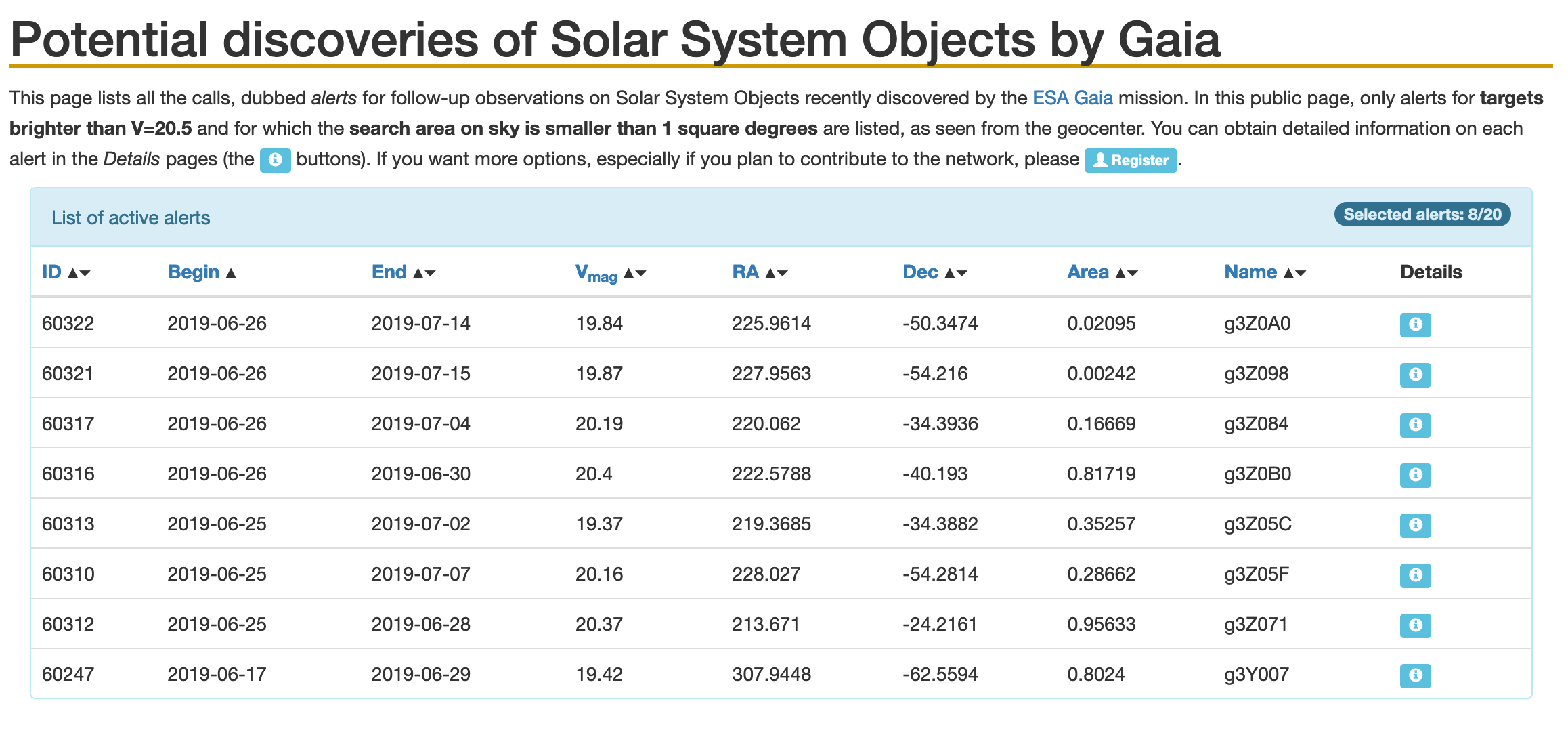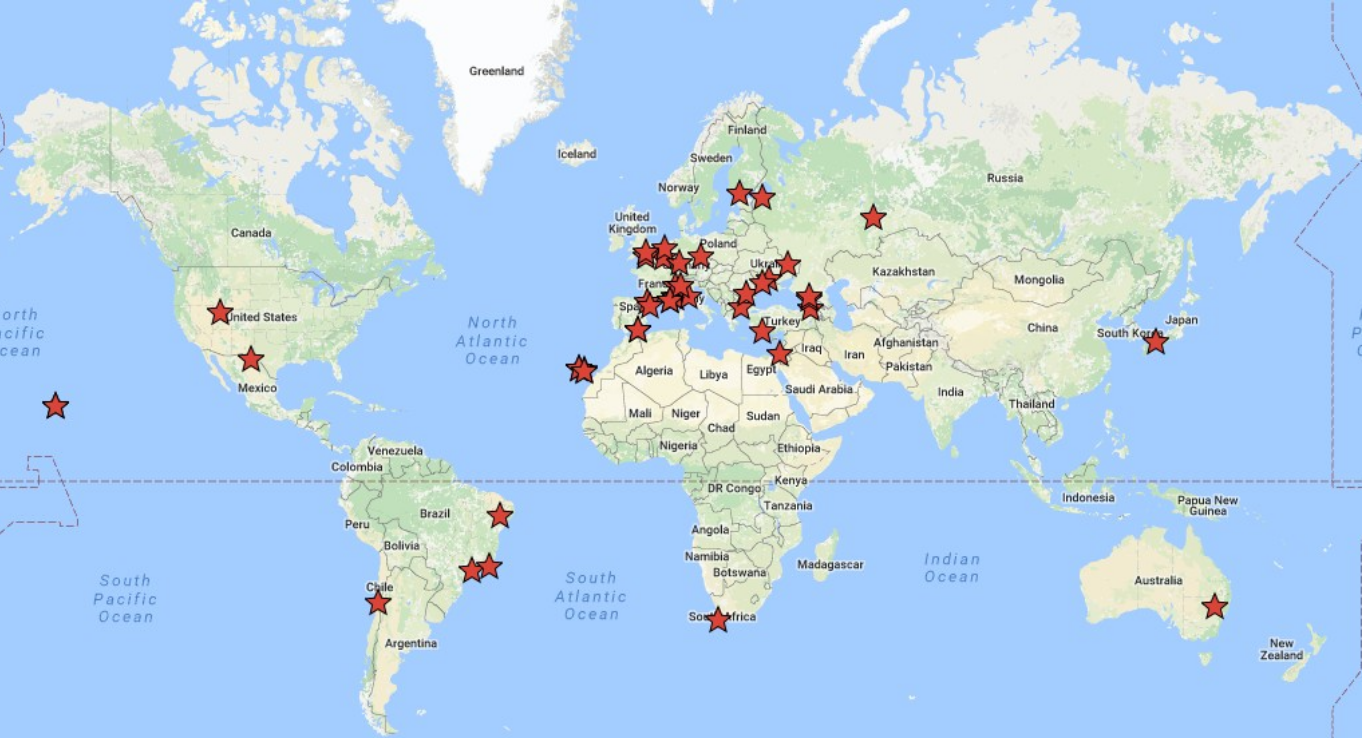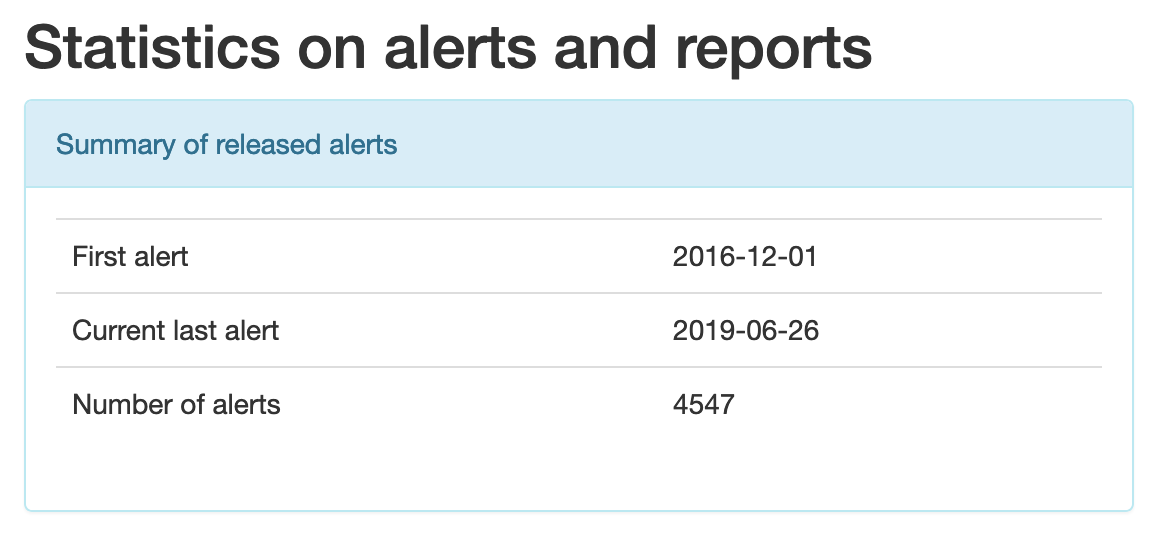IoW_20190628_asteroidday - Gaia
Image of the Week |
Following up on Gaia Solar System Objects (FUN-SSO) |
|
|
|
Figure 1: A list of potential discoveries of Solar System Objects by Gaia is shown in this table, as taken from the FUN-SSO network website on 27 June 2019. Image credit: FUN-SSO network |
|
During Gaia's routine scanning of the sky, it not only observes stars passing in front of the telescope windows, but also anything that is within the detection limit of Gaia and not moving too fast. Next to stars, Gaia thus also observes many asteroids. The first asteroid release from Gaia in Gaia Data Release 2 was only an appetizer for the much larger asteroid catalogue to be released with Gaia Data Release 3, which is currently estimated to contain about 100,000 asteroids with epoch astrometry and photometry, and additional low-resolution spectra for a few thousands of them. Next to releases of asteroid data through the Gaia Data Releases, a pipeline runs daily to extract potential new discoveries of asteroids by Gaia. These candidate asteroids are then published on a dedicated website, called the Gaia Follow-Up Network for Solar System Objects, to allow follow-up by the community with ground-based observatories. Typically, alerts are published within a handful of days of observation by Gaia and can be followed up from the ground for a few days to up to a few weeks, dependent on the number of measurements by Gaia used to compute the expected location of the asteroid for follow-up. Candidate detections are most likely main-belt Asteroids but occasional near-Earth Asteroids are expected to be appear. Gaia is uniquely located which allows to also capture asteroids close to the Sun as seen from Earth, but also to observe asteroids at high latitudes above the ecliptic plane. Figure 2: An overview of observatories and amateur astronomers participating in the Gaia Follow-Up Network for Solar System Objects. Image credit: FUN-SSO network
Observatories or people interested to contribute to the follow-up of these candidate asteroids can create an account for the Gaia FUN-SSO website, specifying their location and telescope which will allow them to see the list of candidate asteroids visible from their location and with their telescope. Typically, asteroid discoveries are in the Gaia magnitude range of about G=18 to G=21, but brighter ones are detected occasionally. Telescopes able to follow-up these alerts are typically 1m class or larger. The observation network is growing, and there is now a more efficient coverage for the southern hemisphere. The network applied and got hours from Las Cumbres Observatory with a joint project Gaia-FUN-SSO and GBOT (the Ground Based Optical Tracking program) in order to validate new Solar System Objects. An alert can be sent to a coordinated network of nine 1m telescopes, located mainly south of the equator. Figure 3: Summary of released alerts. Image credit: FUN-SSO network
With the help of ground-based follow-up observations, Gaia has not only confirmed candidate Solar System Objects discoveries but now also has four announced asteroid discoveries. The video below shows the orbits of these four asteroids:
A visualisation of the orbits of asteroids as observed by Gaia including four recent discoveries. The orbits of the 200 brightest objects are shown in green. In addition, the orbits of the four recent asteroid discoveries by Gaia are shown in pink. This animation starts showing the position of planets, asteroids and stars on Asteroid Day, 30 June 2019; time has been speeded up by 5 million. This visualisation was made using the open-source software Gaia Sky as developed in the Gaia Data Processing and Analysis Consortium. A more extensive description of this visualisation can be found here.
Current designation of the four discovered asteroids by Gaia:
Specifics on the asteroids can be found from the minor planet center. Further reading on Gaia's asteroids:
Interested in following up on Gaia asteroid candidates with your telescope? Get in touch with the Gaia-FUN-SSO network!
|
|
Credits: ESA/Gaia/DPAC, FUN-SSO network, William Thuillot, Paolo Tanga, Federica Spoto, Benoit Carry, Stefan Jordan, Toni Sagristà [Published: 28/06/2019] |
- Removed a total of (10) style text-align:center;
- Removed a total of (4) style text-align:justify;
- Removed a total of (1) border attribute.
- Removed a total of (1) cellpadding attribute.
- Removed a total of (1) cellspacing attribute.
- Converted a total of (1) youtube to youtube-nocookie.
Image of the Week Archive
- Removed a total of (1) border attribute.
- Removed a total of (1) cellpadding attribute.
- Removed a total of (1) cellspacing attribute.








































 Sign in
Sign in
 Science & Technology
Science & Technology


